#uilta
Explore tagged Tumblr posts
Text

Uilta Indigenous girl from Sakhalin Island of Siberia in traditional clothing.
Photo and text by: Alexander Khimushin, from "The World in Faces" photo project. Diversity of traditional cultures of the world through the portraits of Indigenous People.
"Uilta Indigenous People (also known as Orok) are one of the smallest ethnic groups of Siberia living the the Far East. There are only about 200 Uilta People living on this planet. The Uilta language that belongs to Tungusic language family is spoken today by just a very few elderly people.
Uilta Indigenous Peoples home is Sakhalin - the largest Island of Russia stretching for about 1000 km directly to the North of Hokkaido Island of Japan. Recent research indicates that Uilta People are related to Ulchi People and migrated to Sakhalin from Khabarovski Krai, the mainland Russia, around 17th century. At that point in time the Island was a sphere of influence of the Chinese Empire. A hundred years later Sakhalin become administered by both, the Russian Empire and Japan. A penal colony was established on Sakhalin bringing large numbers of Russian political exiles. One of them, Lev Sternberg, became an important early ethnographer on Uilta, Nivkh and Ainu People. After Japan-Russia war, in the 1920s, The Northern part of Sakhalin became part of Russia and the Southern Part became Karafuto Prefecture of Japan. This situation lasted until 1945, when Japan capitulated after the WWII. That's why Uilta People who lived in Poronaysk (also known by Japanese name of Sikuka) and born before 1945 have Japanese names.
My good friend and the spiritual leader of Uita People, Minato Siryuko, is one of them. Living on the shores of the Gulf of Patience every summer, Minato, an honorable elder of Uilta community, performs Feeding of the Spirit of The Sea ceremony, when all Uilta and Nivkh People gather together for an annual celebration that held at summer solstice. In the Sakhalin there were 3 Indigenous Ethnic groups - Ainu, Nivkh and Uilta. When Japan capitulated in 1945 Ainu People were taken by Japanese back to Hokkaido (the Ainu People historical homeland), the Nivkhs and Uilta were considered as natives of Sakhalin and left on the Island. Because of that some Nivkh and Uilta who served in the Imperial Japanese Army were held in Soviet work camps. There is a an abandoned memorial that Minato took me to, with the name of those Uilta who died at that turbulent time. In 2017 I was contacted by LeCiel Foundation team who were making a documentary about 12 highly spiritual elders of Indigenous People from all over the world. They wanted to include to the film Uilta People of Sakhalin as well. A Google search brought them my photos of Uilta. Guys from LeCiel called me from London and told me about their project, I thought it was really interesting and without much hesitation I agreed to take them to Sakhalin Island and to introduce them to Minato, acting as a local fixer and translator at the same time)) Then, during the filming, The LeCiel founders unexpectedly invited Minato to the United Nations. The invitation was also sent to all twelve Indigenous leaders who were filmed. She really wanted to travel there, but was afraid going alone, so I was offered to accompany her (I had to come back from Mongolia where I was filming my own project) This is how the Uilta Indigenous People spiritual leader from Siberia and a nomadic photographer, living in Australia at that time, ended up at the United Nations in New York City together!
What happened next? Well… many interesting things, I can assure you, but I will tell you about it next time! )) You can watch that amazing documentary film, THE TWELVE, with several language subtitles. I put the link in the comments. You can also see my photo with my dear Minato, taken during the time of filming in Sakhalin! I put it in the comments as well."
#uilta#siberia#oroks#ethnography#russia#Ульта#documentary photography#siberians#photojournalism#ulta#Ороки#northern asia#ulcha#Sakhalin#northeast asia#russian far east#russian#russians#siberian#siberian people#indigenous#indigenous women#native#native women#native siberians#indigenous siberians#native people#asia#asian#alexander khimushin
86 notes
·
View notes
Text
#paleta post#folk costume#siberia#indigenous fashion#indigenous peoples#sakha#ulchi#nivkhi#evenki#tofalar#even#orogen#buryat#dolgan#tuvan#uilta#udege#semeyskie#tazy#nanai#ainu#chukcha#Alexander Khimushin#photography
12 notes
·
View notes
Text


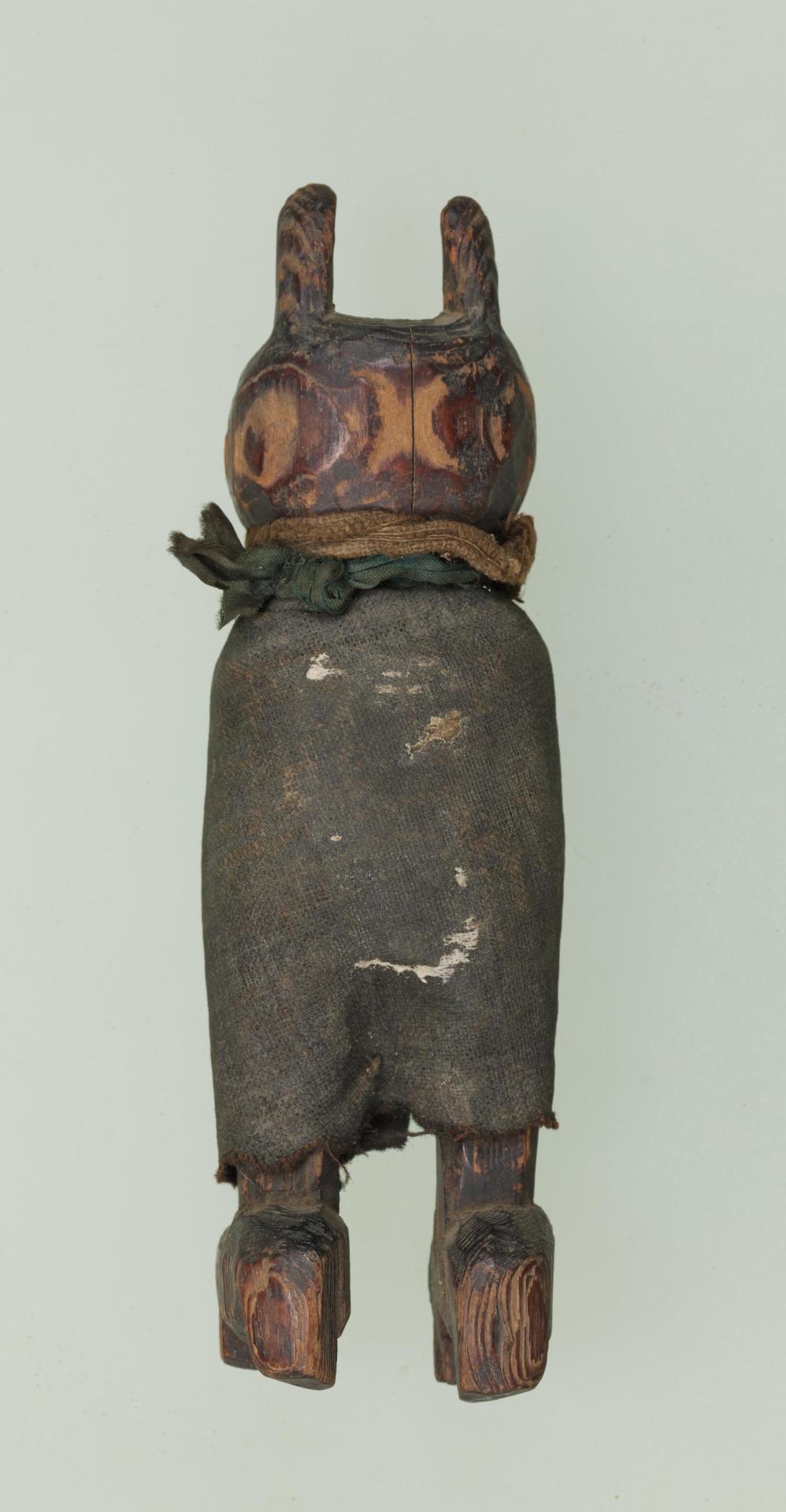



Sakhalin, Uilta - Pouch, 19th. Century. Fish skin (Sturgeon) .
Sakhalin Uilta / Figurine, 19th. century. Wood and cotton. .
Sakhalin Uilta / Figurine, 19th. century. Wood. .
Becoming Japanese: The Story of the Indigenous Uilta of Sakhalin
7 notes
·
View notes
Text









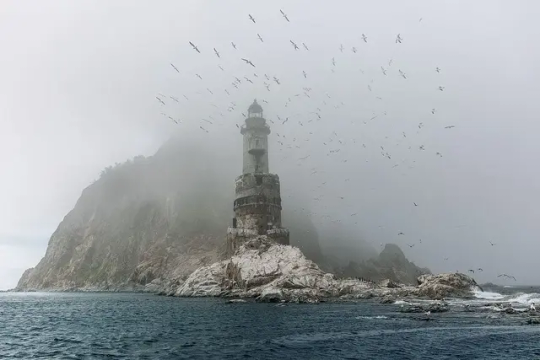
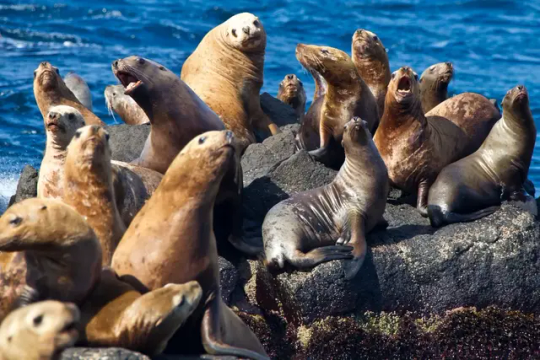



















Сахалин — крупнейший остров России — расположен на Дальнем Востоке, у побережья Евразии. По площади он сравним с Чехией или Сербией и лишь немного уступает Ирландии. Омывается сразу двумя морями — холодным Охотским и более тёплым Японским.От южной точки острова до японского острова Хоккайдо всего 44 километра.
Первые люди поселились здесь ещё в доисторические времена. Самой древней стоянке человека, обнаруженной археологами на Сахалине, около 230 тысяч лет. Местное коренное население — их осталось около трёх тысяч человек — племена оленеводов уйльта и эвенков и рыболовов нивхов до сих пор живут согласно древним традициям.
Большинство путешественников едет на Сахалин ради природных красот. Здесь есть действующие вулканы, горячие термальные источники, и изумрудно-зелёные скалы. Растительность на острове довольно необычная. На севере можно прогуляться по тайге, а на юге и западе — увидеть несколько видов лиан и курильский бамбук. А ещё на Сахалине есть «ботаническое чудо света»: папоротники, крапива, гречиха и другие травянистые растения в некоторых местах вырастают на высоту до 3-5 метров. При этом на материке из их семян появляются растения обычной высоты.
На Сахалине умеренный муссонный климат с высоким уровнем влажности, дождливым летом и холодной, снежной зимой. Летом часто появляются туманы, создающие таинственную атмосферу. В конце лета и начале осени бывают тайфуны. Осень мягкая, яркая и тёплая, почти без дождей. Погода на Сахалине непредсказуемая, по��тому лучше быть готовым к любым капризам природы.
На озере Тунайча гнездятся разные виды птиц, а на Тюленьем острове близ Сахалина находится крупное лежбище тюленей и огромные птичьи базары. В окрестностях самой высокой точки острова — горы Вайды — расположены карстовые пещеры. С вершины горного хребта Жданко открывается вид на живописные окрестности. На мысе Великан можно увидеть природные арки, гроты и столбы, которые возникли под воздействием ветра и соленой морской воды.
Подходящее для туризма время на Сахалине — с мая по сентябрь. К маю почти везде сходит снег и уже можно отправляться в путешествие по острову.А самое популярное для путешествий по Сахалину время — тёплый и солнечный август. В этом месяце лучше всего исследовать дальние уголки острова, купаться в море (вода в этом месяце иногда прогревается до +21 °C) и пробовать лесную голубику и чернику.
Sakhalin, Russia's largest island, is located in the Far East, off the coast of Eurasia. In terms of area, it is comparable to the Czech Republic or Serbia and is only slightly inferior to Ireland. It is washed by two seas at once — the cold Sea of Okhotsk and the warmer sea of Japan.It is only 44 kilometers from the southern point of the island to the Japanese island of Hokkaido.
The first people settled here in prehistoric times. The oldest human site discovered by archaeologists on Sakhalin is about 230 thousand years old. The local indigenous population — there are about three thousand people left — the tribes of reindeer herders Uilta and Evenks and fishermen Nivkh still live according to ancient traditions.
Most travelers go to Sakhalin for the sake of natural beauty. There are active volcanoes, hot thermal springs, and emerald green rocks. The vegetation on the island is quite unusual. In the north you can walk through the taiga, and in the south and west you can see several types of lianas and Kuril bamboo. And also on Sakhalin has a "botanical wonder of the world": ferns, nettles, buckwheat and other herbaceous plants in some places grow to a height of 3-5 meters. At the same time, plants of normal height appear from their seeds on the mainland.
Sakhalin has a temperate monsoon climate with high humidity, rainy summers and cold, snowy winters. In summer, fogs often appear, creating a mysterious atmosphere. There are typhoons in late summer and early autumn. Autumn is mild, bright and warm, with almost no rain. Weather on Sakhalin is unpredictable, so it's better to be prepared for any whims of nature.
Different species of birds nest on Lake Tunaicha, and on Seal Island near Sakhalin is home to a large seal rookery and huge bird markets. Karst caves are located in the vicinity of the highest point of the island ��� Mount Vida. From the top of the Zhdanko mountain range, you can enjoy a view of the picturesque surroundings. At Cape Giant, you can see natural arches, grottoes and pillars that arose under the influence of wind and salty sea water.
A suitable time for tourism on Sakhalin — from May to September. By May, snow is falling almost everywhere and you can already go on a trip around the island.And the most popular time for traveling around Sakhalin is warm and sunny August. This month, it is best to explore the far corners of the island, swim in the sea (the water sometimes warms up to +21 °C this month) and try wild blueberries.
Источник://bolshayastrana.com/blog/top-dostoprimechatelnostej-sahalina-229,//experience.tripster.ru/articles/sahalin/, /sakhtravel .com/tury-po-sahalinu/tury/tvoya_yarkaya_zima_na_sakhalin, ://wikiway.com/russia/sakhalin/photo/, https://www.tripadvisor .ru/LocationPhotos-g4355184-Sakhalin_Sakhalin_ Oblast_Far _Eastern _District.html,//www.culture.ru/institutes/34988/ostrov-sakhalin, ://tonkosti.ru/%D0%A4%D0%BE%D1%82%D0%BE_%D0%A1%D0%B0%D1%85%D0%B0%D0%BB%D0%B8%D0%BD%D0%B0?utm_referrer=https%3A%2F%2Fwww.google.com%2F.
#Russia#Sakhalin#nature#nature aesthetic#landscape photography#mountains#lake#trees and forest#Lighthouse Aniva#blue sky#sea lions#travel#wonderful#nature video#nature photography#Россия#Сахалин#природа#Пейзаж#горы#лес#озеро#Маяк Анива#сивучи#небо#туризм#видео природы#природнаякрасота
195 notes
·
View notes
Note
Wondered if you answered this or not but did Wilk genuinely love Asirpa’s mother or no? I’m sure he loved Asirpa but idk about her mom because not much info about her but I can see why he married her when we saw how she was like aside being the chieftain’s daughter.
This also made me think too since Kiro saw a change in Wilk and saw he wasn’t in for the revolution much anymore but mainly for the Ainus now, somewhat told me that having Asirpa changed him or learning about Ainu culture or something. Or maybe it’s just my imagination shrug.
Another is did Kiro realize who Tsurumi was or he never realized Tsurumi was the glasses dude bc only Wilk did.
Well...
chap 254 has Wilk tell Asirpa he loved her mother.
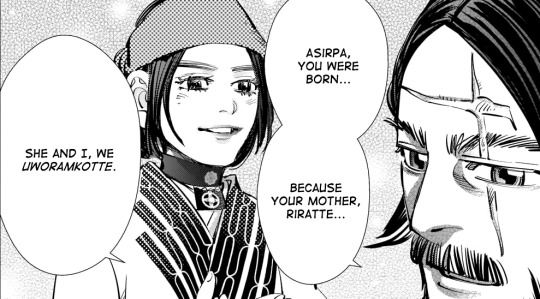
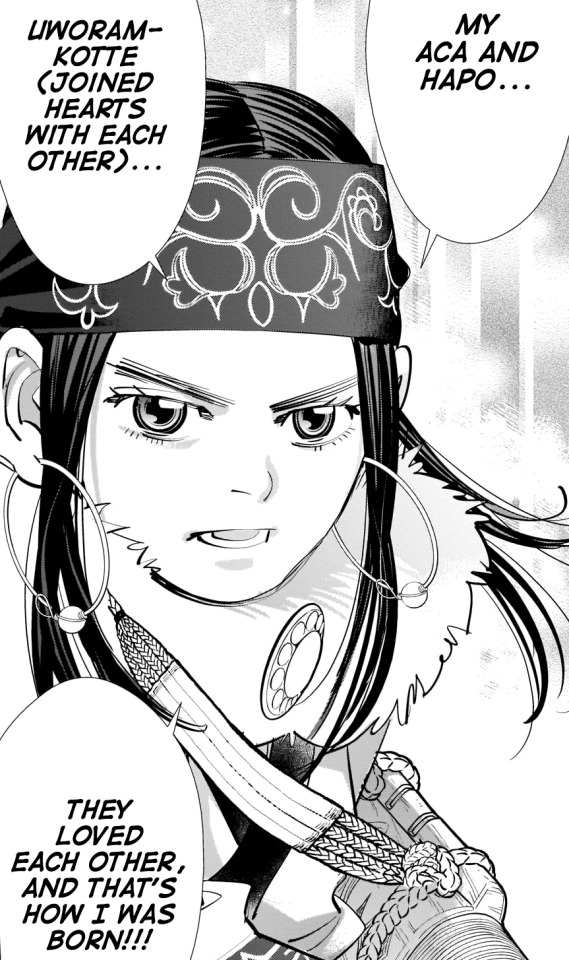
We've no reason to think Wilk lied so I take this is the truth.
As for Wilk... it was Sofia who was in for the revolution, Wilk and Kiro were always in for the minorities. Sofia is a revolutionary, Wilk and Kiro are partisans (as well as Karafuto Ainu, though Kiro has also Tartar blood and Wilk Polish blood). Wilk's goal was to create a far eastern federation for minorities so that their culture and way to live would survive.
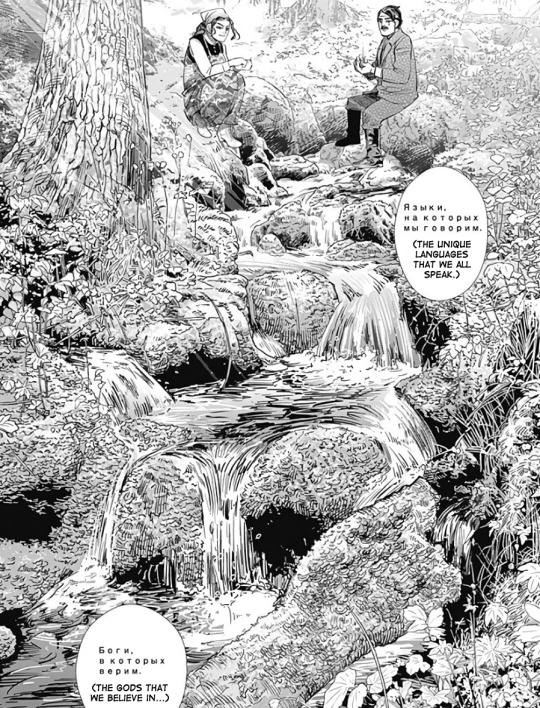
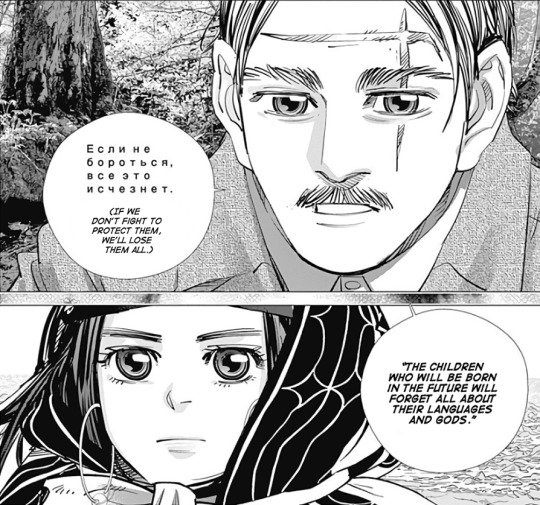
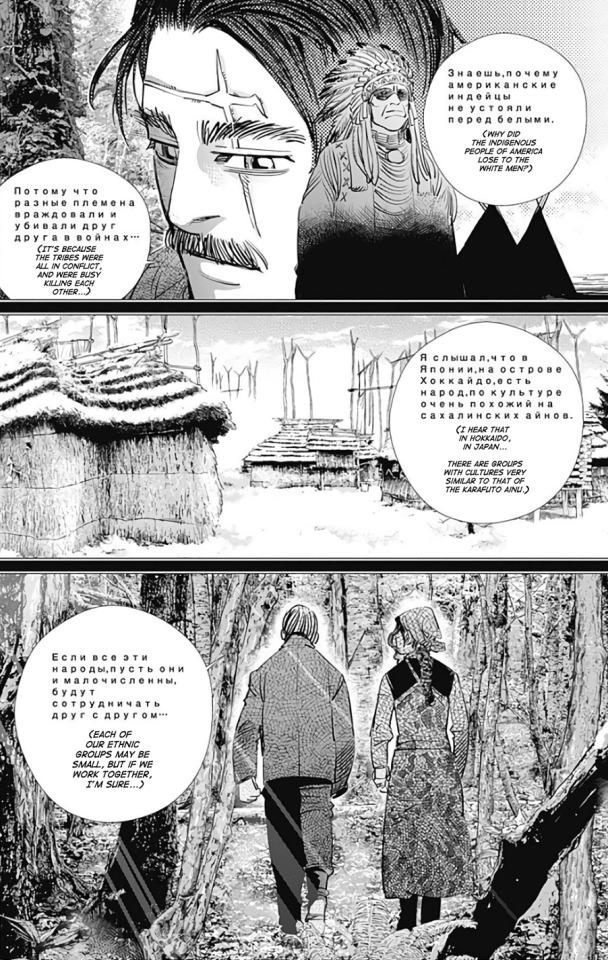
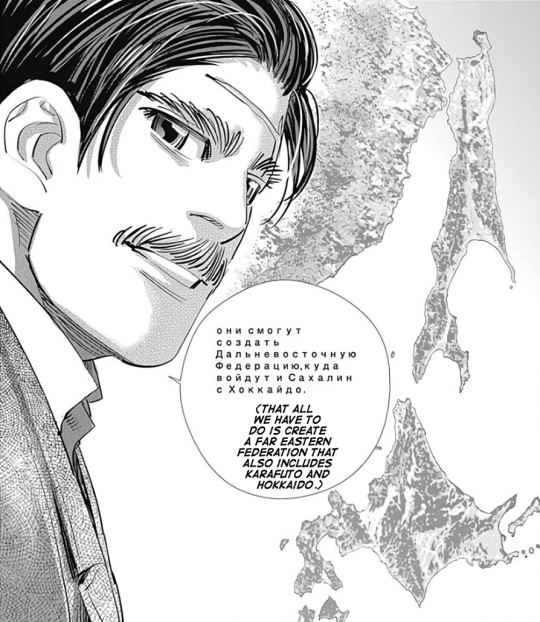
However, after he moves in Hokkaido and has Asirpa Wilk changed his plan.
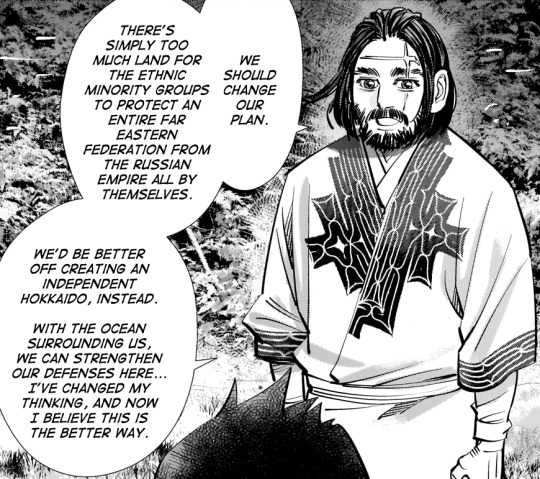
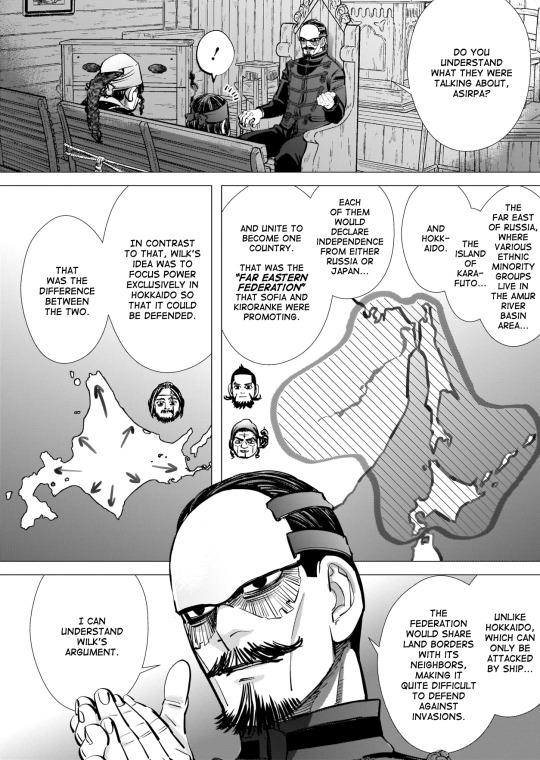

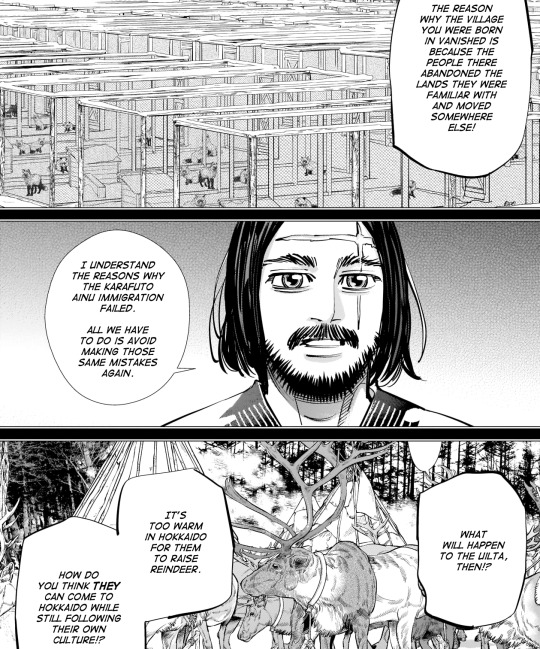

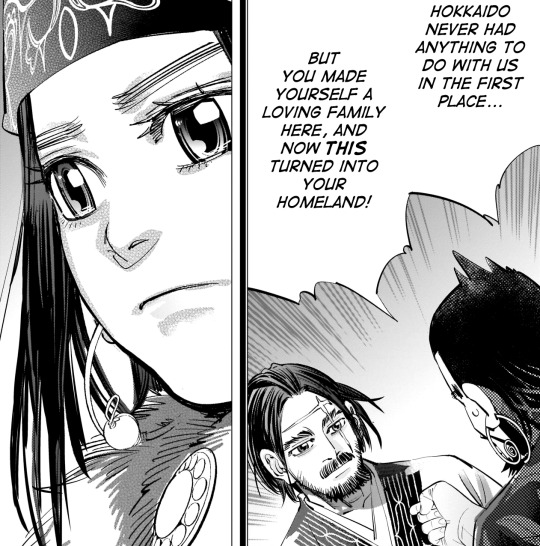
As you can see their discussion is focused solely on the minorities, not on improving the conditions of all the people in Russia, that was Sofia's goal.
Wilk claims he believes his change of plans is due to his new plan being the best option, Kiroranke doesn't believe him and claims he's moved merely by how he now views Hokkaido as his home.
It's up to the reader to decide if Kiro is right or wrong.
If you ask me they're both right. Wilk's plan is easier, but Wilk can go through it and ABANDON PART OF HIS COMRADES IN RUSSIA, because to him now Hokkaido matters MORE, so it's easier for him to sacrifice them (though, to be honest, Wilk was never shown as one who had problems cutting loose companions who made his life complicate).
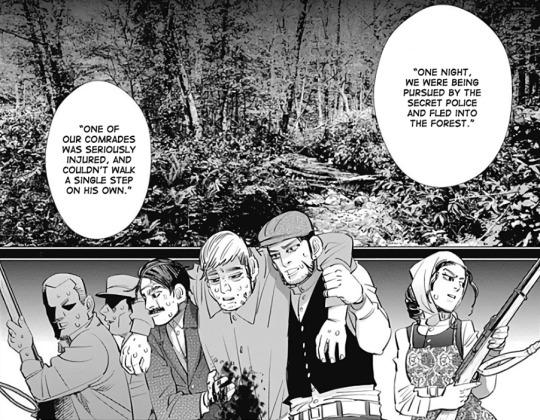
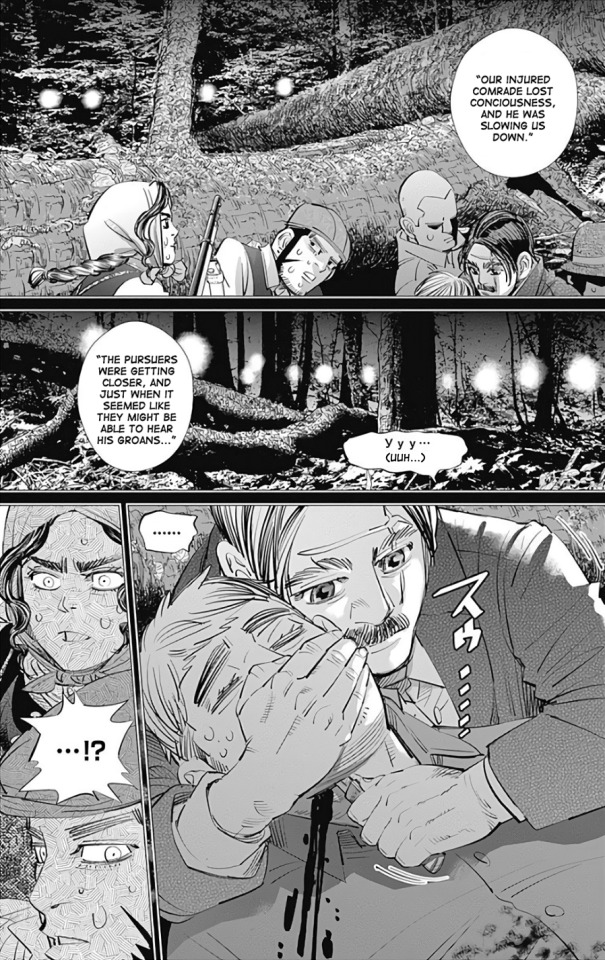
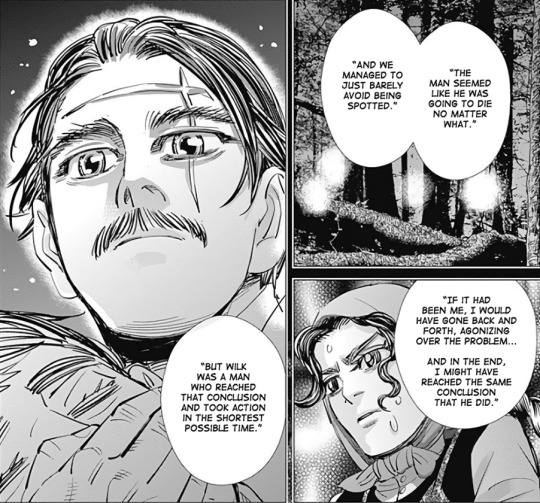
So for him dumping the Uilta wasn't really a problem.
Kiroranke never met Tsurumi up close so, as far as we know, he never had the chance to realize he was Hasegawa.
It was just Wilk and Sofia who got to give Tsurumi a good look and could realize who he was.
17 notes
·
View notes
Text

i really do wonder how the communication between the jpn & ru parties went because it's a mess... i can make a guess that the russian translator was given the raw japanese text with no context whatsoever, like no images or prior chapters, and asked to translate it as is... bc in japanese it indeed says "did you shoot the wanted man" with the particle が, which is extremely easy to miss without context and subconsciously read as は; if you do that, the line will become "was the wanted man the one who shot". which is what is written in russian. and because of this line the line above is thrown off too and makes no contextual sense. alas!
also vasily is saying "how would some uilta guy get the latest japanese gun". "uilta" is the name that the uilta people have given to themselves. russians and the ainu were calling them "oroks". so it would make much more sense for a russian, even one who works at the border, to call them oroks instead of uilta. funnily enough that's the way it seems to have been in the magazine release...

it seems to have been corrected in the volume release. why though, if the magazine version makes more sense? and if the russian translator reviewed the lines for the volume, why not correct the ones that were COMPLETELY off the mark? very bizarre
#i know i'm nitpicking the logistics of all this are just of urgent interest to me#i don't think i could ever translate manga for a living bc it would mess with my boundaries but it's still interesting to me...#gkposting
2 notes
·
View notes
Text
1 note
·
View note
Text
Orok Indigenous
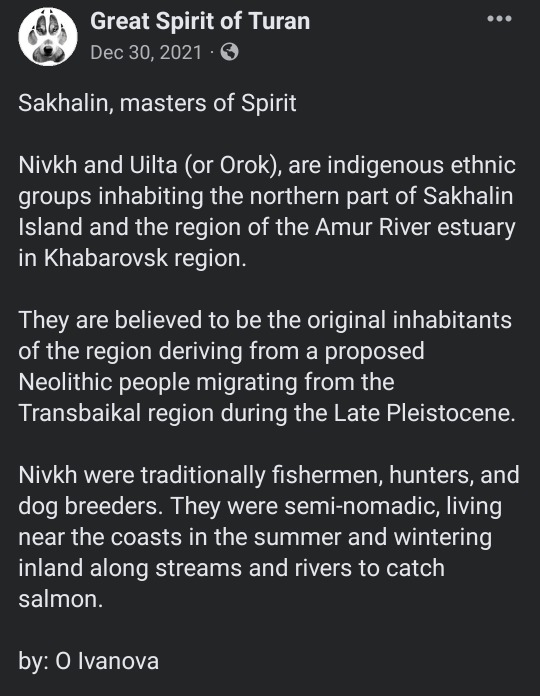
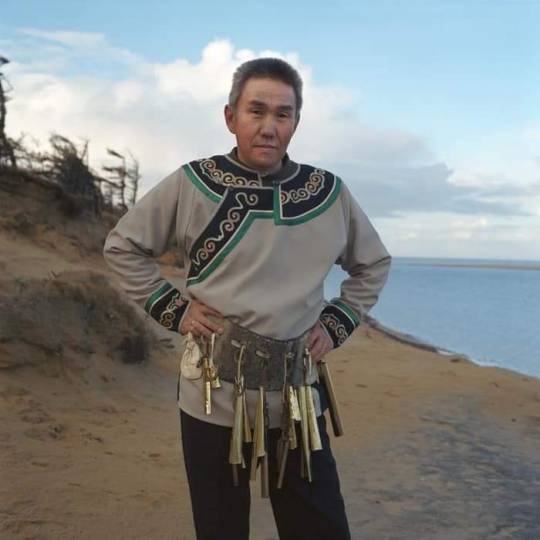
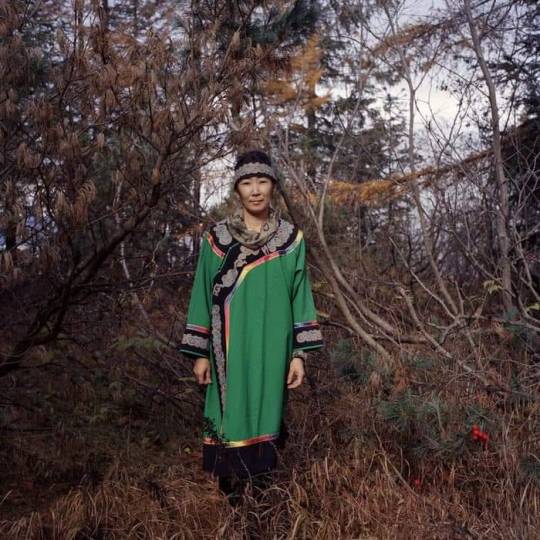
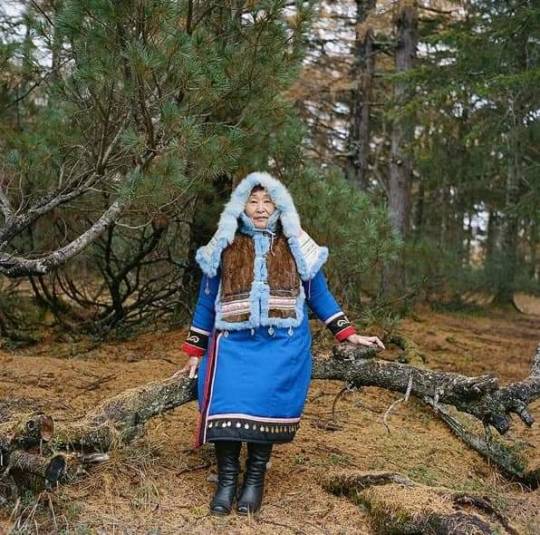
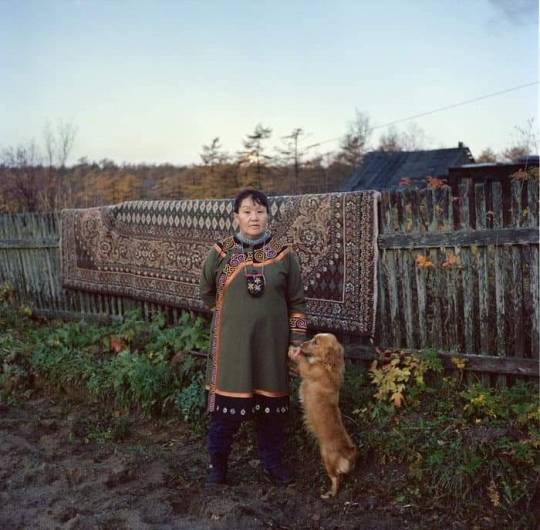
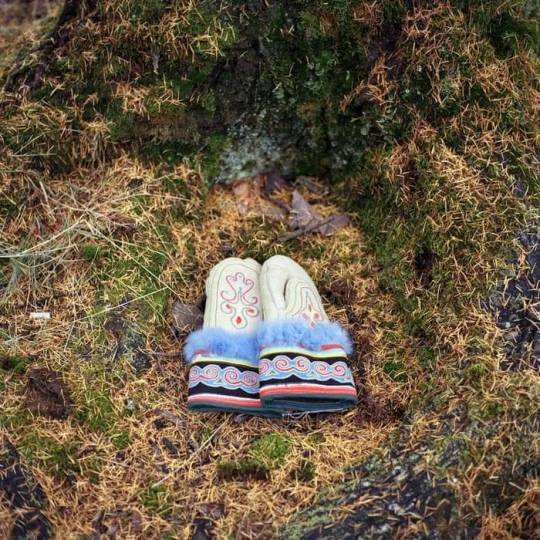


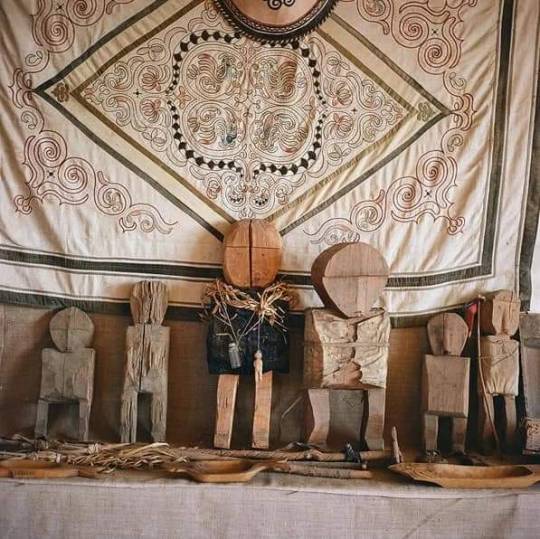
#indigenous#culture#indigenous russia#indigenous russian#russia#important#fypシ#colonization#fypage#landback#siberia#siberian indigenous#indigenous siberian#nivkh#Orok#Uilta#endangered languages#endangered#indigenous people#indigenous culture#russian imperialism
64 notes
·
View notes
Text

Orok woman, Russia, by Olya Ivanova
#orok#russia#asia#north asia#folk clothing#traditional clothing#traditional fashion#cultural clothing#uilta
391 notes
·
View notes
Photo
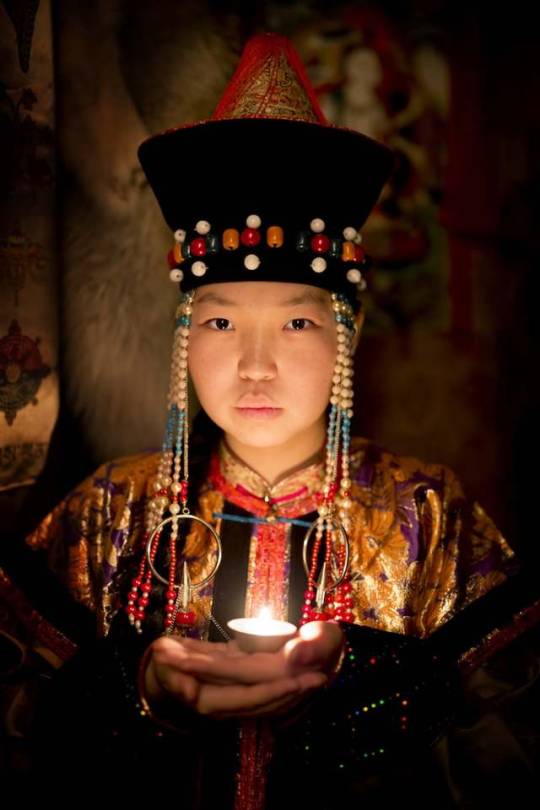

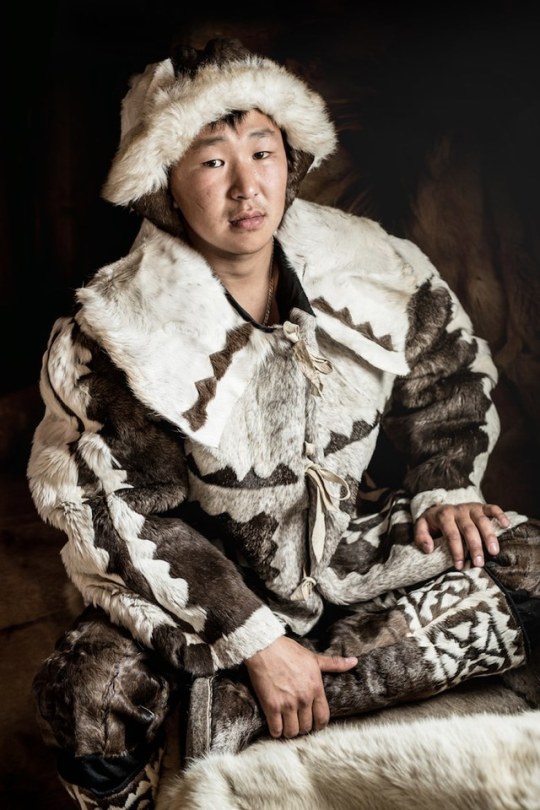

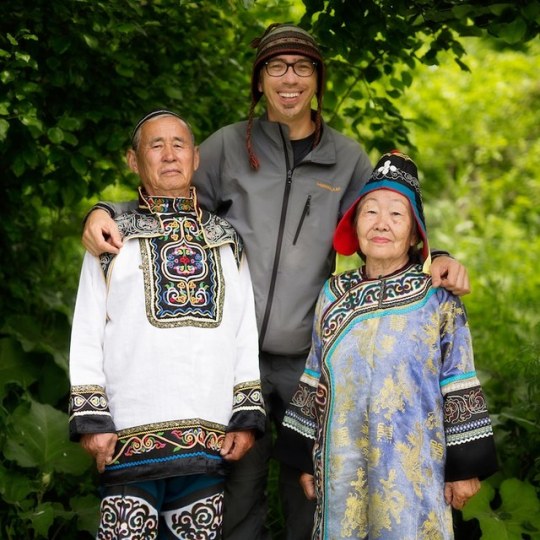
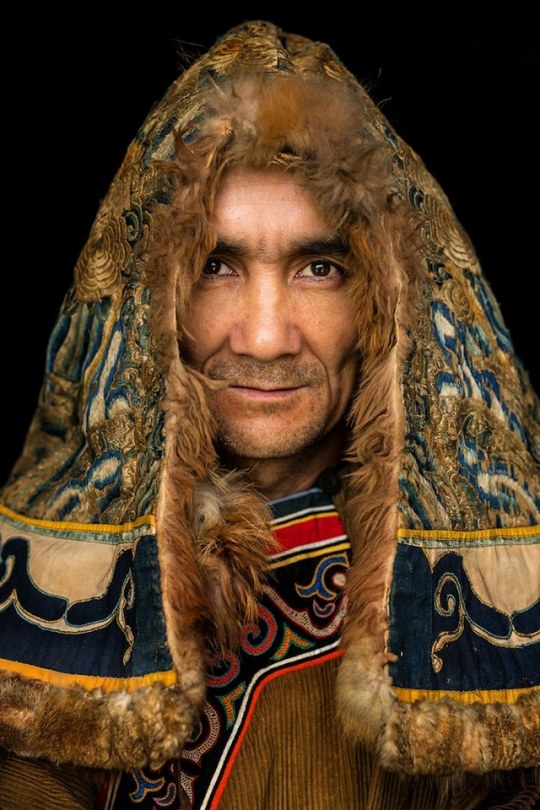
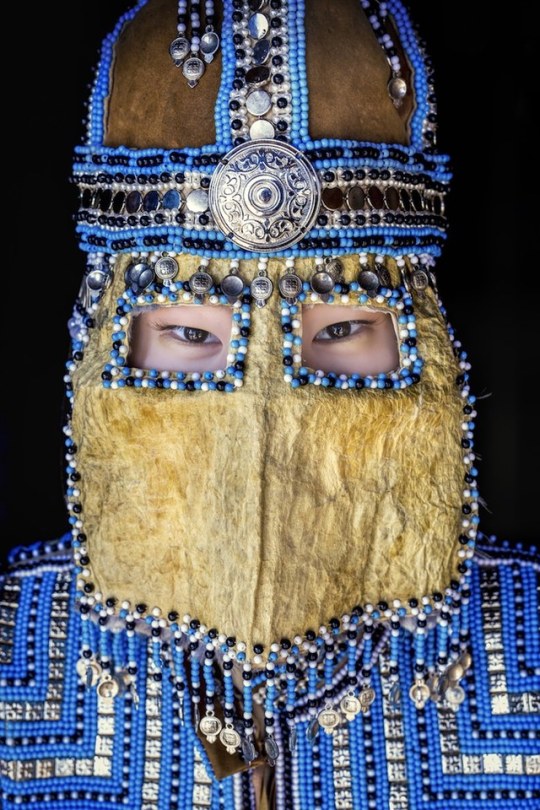
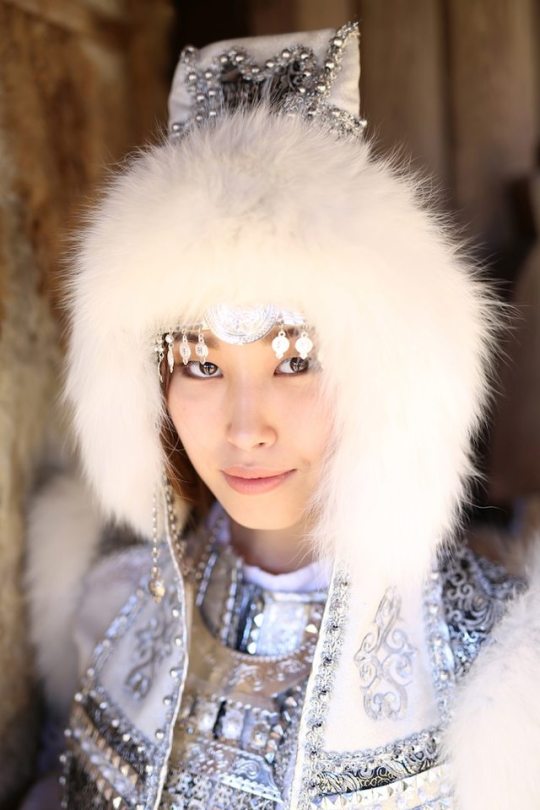
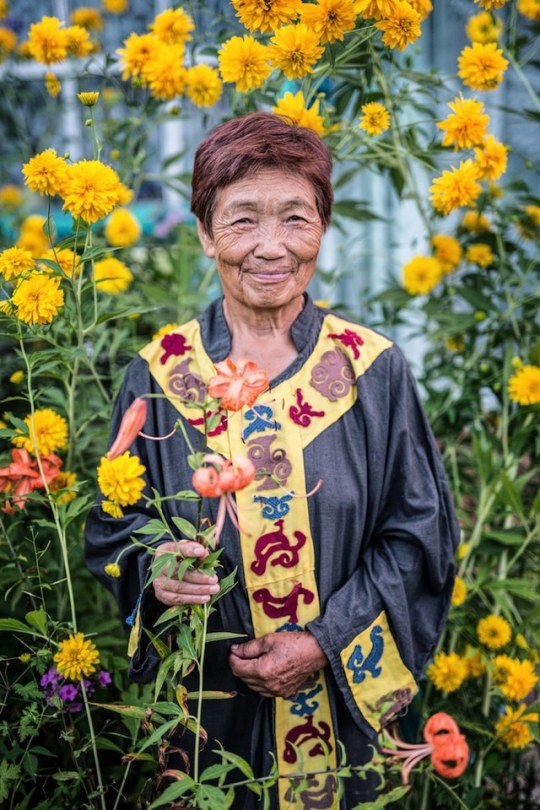
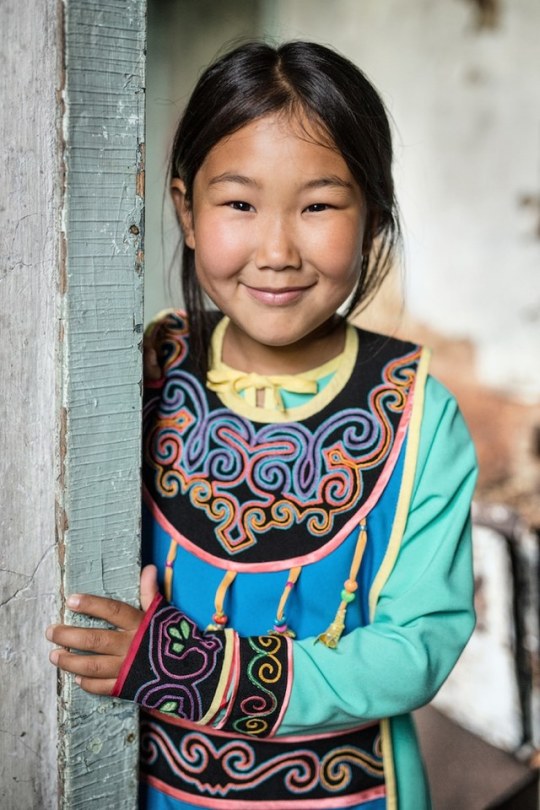
Portraits of the people of Siberia by Alexander Khimushin
1. Buyat girl, Buryatia Republic, Siberia (ethnic Mongols) 2. Dolgan girl, Republic of Sakha, Siberia 3. Even young man, Yakutia, Siberia (the Even are a different group than the Evenki) 4. Nanai girl, Siberia 5. Nanai people with the photographer, Siberia 6. Nivkhi man, Siberia 7. Sakha girl in traditional wedding mask, Siberia 8. Sakha girl 9. Tazy woman, Siberia 10. Uilta girl, north of Sakhalin Island, Siberia
#fashion#alexander khimushin#siberia#siberian fashion#buyat#dolgan#even people#nani#nivkhi#sakha#tazy#uilta#men's fashion#bridal fashion#masks
5K notes
·
View notes
Text
Another excellent article from Unseen Japan that covers what happened with Karafuto and the ‘lingering’ issues of Japanese colonialism
I’ve been enjoying this series from one of the staff writers - they are well researched and articulate.
https://unseenjapan.com/uilta-sakhalan-japan-part-1/
There is a second part as well which is only available to patrons at present, but it seems their articles will open up after a period of time.
This is the same group that made the video about Hokkaido that I previously posted here.
15 notes
·
View notes
Link
Abstract: Indigenous people are often depicted as helpless victims of the forces of eighteenth and nineteenth century colonial empire building: forces that were beyond their understanding or control. Focusing on the story of a mid-nineteenth century diplomatic mission by Sakhalin Ainu (Enchiw), this essay (the first of a two-part series), challenges that view, suggesting instead that, despite the enormous power imbalances that they faced, indigenous groups sometimes intervened energetically and strategically in the historical process going on around them, had some impact on the outcome of these processes. In Part 1, we look at the story of one Sakhalin Ainu family over multiple generations in order to highlight the strategic place of the Sakhalin Ainu in cross-border relationships – particularly in the relationship between China and Japan – from the early eighteenth to the mid-nineteenth century.
The Mission
In late December 1853, about six months after US Commodore Matthew Perry arrived in Uraga Bay on his mission to ‘open’ Japan to the world, a Sakhalin Ainu (Enchiw) elder named Setokurero set out from the village of Nayoro on the west coast of Sakhalin island on his own crucial diplomatic mission.1 He travelled in a convoy of fifteen dog sleighs through the winter blizzards, accompanied by a retinue of some twenty Ainu elders from surrounding villages and one Nivkh man from the Amur region of mainland Asia.2 They were heading for Kushunkotan on the southern shores of Sakhalin, where the Japanese had established a fortified trading post in the early nineteenth century, and where the Russians had also recently landed to stake their rival claim to the island. The aim of the Ainu elders’ mission was to learn more about Russo-Japanese competition for control of Sakhalin, to express their own views on the matter, and to seek Russian help in resisting Japanese exploitation of the Ainu.
The Ainu of Sakhalin, Hokkaido and the Kurile Islands, like the Nivkh and Uilta indigenous peoples who also inhabited Sakhalin, lived in small self-governing villages and did not have any single dominant chief, but Setokurero was a particularly well known and influential elder. He was respected for his oratorical skills3, and his village and family had a special place in Sakhalin history (which we will explore further). His coastal community of Nayoro was – in terms of the modern concept of towns or even villages – tiny. In 1853, it consisted of six houses on either bank of a small marshy river, containing a population of around fifty people.4 But it was a crossroads and emporium on a far-reaching trade route whose tentacles stretched, at one end, deep into the heartland of the Chinese Empire, and at the other end to the Shogunal capital of Edo (soon to become Tokyo) and beyond.5 From the Chinese side, items like silk brocade, cotton cloth, metalware, decorative blue beads, tobacco and smoking pipes flowed into Nayoro and other points on the Sakhalin trade route, and some of these goods (particularly Chinese brocades) travelled on to the luxury goods markets of Japan. From the Japanese side came items such as rice, saké, miso paste, and pots and pans. The medium of exchange was ‘soft gold’ (as the Russians called it): fur, in the form of the pelts of sable, fox, sea otters and other animals hunted by the indigenous people of the region.
Read more...
https://apjjf.org/2020/22/Morris-Suzuki.html
#indigenous#ainu#nivkh#uilta#international relations#indigenous diplomacy#diplomacy#history#sakhalin ainu#east asia
11 notes
·
View notes
Text
something about tribes
I’ve been to the Asahikawa City Museum the other day and saw the Ainu exhibition there. Today’s reading practice’s about tribes the Ainu had (or still have) contact with. It’s hardly any information, so if you’re interested, you can look them up elsewhere.
I couldn’t find much about the Enchu tribe, but more information about the other tribes described below can be found on google. check the tags for alternative names.
well have fun practicing
ニブㇷのくらし
ニブㇷはサハリン(樺太)の北部に居住しています。同様の文化をもつ人びとがアムール川最下流域におり、自らをニブㇷと称します。
人びとにとって、春から秋は海獣狩猟や漁撈の季節であり、冬は山野で狩猟を行います。漁獲した魚は夏の家の周囲に設けた魚干棚で乾燥され、冬の貯えとなります。
人びとは多くの犬を飼い、輸送に使役されるほか、肉や毛皮を人びとにもたらします。また、犬は種々の品物と交換され、その数は貧富の指標とされます。
エヴェンキのくらし
中国東北部、大・小興安嶺付近に居住するエヴェンキ(オロチョン)は、馬を飼養するグループとトナカイを飼養するグループに分かれます。いずれも狩猟を主な生業としており、獲物を求めて移動生活を行い、獲物の肉は食用に、毛皮は中国とロシアとの交易に用いられています。
トナカイ、馬の飼養は、極北地方のツンドラや中緯度の半乾燥草原における大規模な飼養とは異なり、小規模なものです。これらの家畜は、人びとの大切な財産であり、荷の運搬や乗用に使役されます。
エンチュウのくらし
エンチュウはサハリン(樺太)南半に居住し、樺太アイヌと他称されます。
冬、エンチュウは山辺のトィチセ(土の家)と呼ばれる竪穴住居で暮らし、海や山野で狩猟を行い、春になると、海辺のサッチセ(夏の家)へ移ります。秋までは漁撈の季節です。多量に捕獲したサケ・マスは干魚にされ、主に冬の食料に利用します。
人びとはテンをはじめとする毛皮や干魚��中国や北海道を介して本州と交易を行い、鉄製品や玉などを入手しました。
ウィルタのくらし
ウィルタは、サハリン(樺太)中北部で、トナカイを飼養していますが、その数は多くはありません。
春から秋は漁期です。川口近くに建てた夏の家で、漁獲した魚を越冬用に加工します。漁期が終わると冬の家で、春までトナカイと共に移動しながら、山野で狩猟を行います。
トナカイは荷物の運搬などに使役される他は、人びとの生活を支えるほどのものではなく、その飼養は副次的なものにすぎません。
#reading practice#japanese#tribes#nivkh#nivkhi#evenki#evenks#oroqen#orochon#uilta#oroks#enchu#ainu#読み練習#日本語#民族#アイヌ人#アイヌ#アイヌ文化#ニブフ#エヴェンキ#オロチョン#ウィルタ#エンチュウ#japan#hokkaido#china#russia#sakhalin#日本
1 note
·
View note
Text
A little etymology journey starting from Bugaeva's Handbook of the Ainu Language:
Inasa ([Japanese place name]) < Ainu inaw-san ‘the place where inaw [are offered]’. Attested in: MYS 14.3429.
She further describes it:
Direction of borrowing: Ikegami (1980) has made a detailed investigation of inaw (SA) ‘shaved wooden offering’. The inaw is the most fully developed in the Ainu culture. Among the Nivkh and the Tungus ethnic groups, only the shaved portion without a shaft is used. In the Uilta culture and the Nivkh culture in the southern areas, inaw with a wooden shaft are used, but considering the distribution, this is under influence from the Ainu culture.
I looked up what inaw/inau are, because clearly this is an Ainu religious concept, which Wikipedia has a page on. The page gives the following etymology from Toshirou's 「サハリンの言語世界 : 単語借用から見る」:
The word inau appears to be a loanword from other languages in the region, probably the Orok language of Sakhalin (cf. Orok illau < *ilawun). It is most likely ultimately related to Manchu ila-l ᡳᠯᠠᠮᠪᡳ (ila-mbi) "to blossom" and ilhal ᡳᠯᡥᠠ "flower." The Nivkh word inau ~ nau is most likely a loanword from the same Manchu-Tungus source via Ainu [...] ."
According to Ikegami's "Remarks on the origin of the Ainu word inaw", the Orok/Uilta word illau is likely derived from *ilawun -- a verb stem *ila- and a "substantive-forming suffix *-wun which means instrument, etc." Supposedly *ilawun refers to "a stick which puts forth flowers" (weird translation), and it would make sense for *ila- to be similar to Manchu ila-l "to blossom" -- or a "blooming stick" in reference to the long shavings that hang off the tip of the stick/staff. Whenever the ritual wood-shaving stick was loaned(?) into Ainu culture the term for it came along bearing that exact meaning. I'd be interested to see some comparative religion stuff between Orok/Uilta and Ainu use of the inau.
And while Japanese Shinto has similar 'stick with droopy things on top' things going on (the oonusa and the gohei) -- an interesting question arises about how Shinto might relate to Ainu religion in that way -- it seems at least according to Bugaeva that the Ainu concept of the inaw only survives in Japanese as the place-name Inasa. My Google-fu only leads me to Inasa, Shizuoka and Mount Inasa in Nagasaki. There are several mid-Honshu locations with suspected Ainu placenames so Shizuoka's Inasa makes sense as an Ainu etymology. However, Mount Inasa (稲佐山) is probably just from some relation to rice (稲 ine), and I don't think there's any evidence the Ainu ever went as far South as Nagasaki.
The more interesting direction to me is Ainu into Nivkh. Proto-Nivkh borrowed the Ainu word *inaw as "ritual staff" (sourced from Wiktionary but ultimately from Fortescue's Comparative Nivkh Dictionary). I'm not sure if that is supposed to be a specific ritual staff (in this case an inaw-shaped one) or just any staff used in a ritual. Fortescue lists *inaw as "ritual staff (shaman's) [made of a bunch of wood shavings, an Ainu word -- cf. Black 1973: 12]".
That citation by Fortescue is Lydia Black's "The Nivkh ("Gilyak") of Sakhalin and the Lower Amur" in Arctic Anthropology Vol. 10, No. 1 (1973). A short excerpt from that chapter, though it mentions "inau" in different rituals no less than 25 times:
When a Nivkh cuts down a tree, on the stump he reverently places inau - a small wooden stick cut into strips of shavings at least at one end. Inau is believed to preserve the soul of a thing, animal or person. It is a symbol of lifegiving (Shternberg, 1904b:20).
Keeping that description in mind with all the other uses of inau which Black describes, it seems there is simply a wealth of (comparative AND specific) religious thought to dive into. Consider this description of Ainu inaw practice from the Inau Wikipedia page:
With the exception of funerals, for which they were never made, inau were an important part of rituals involving kamuy. Because only men were permitted to participate in religious rituals besides the bear ceremony, only men could make inau. Before building a house, four inau and one chiahorokakepe were placed where the hearth was to be built.
Now consider this excerpt from Black:
Construction of a new winter dwelling was a cooperative enterprise, concerning all resident lineage members and even af fines. […] Such construction, representing commencement of a new life, so to speak, was an important event fraught with symbolic significance and was accompanied by a variety of complex rituals. Construction at every step required ritual action (Shternberg, 1933:314; Taksami, 1961:159-164). Some of these rituals were conceived as "strengthening the house." An example of this type of ritual was the final act of the construction: the placement of two poles decorated with carvings of symbolic significance, one at each end of the house along the longitudinal axis. The poles were joined by a string on which were hung representations of the sun (female, in Nivkh world view), the moon (male), and bunches of wood shavings called tsakh or chakh and often referred to in Russian literature by their Ainu name inau, which were used in all Nivkh rituals. This "strengthening of the house" was believed to lessen the danger of penetration by dangerous or hostile spirits (Shternberg, 1893:20; 1933: 317; Taksami, 1961:163). This contraption with all the emblems was never removed, but was left in place until it deteriorated from natural causes.
Interesting correlations between inau, housing, and gender, and actually correlates with the use of male pronouns in my first quote from the paper -- I didn't read the whole thing but it seems inau are specifically associated with men in both Ainu and Nivkh culture. However it seems the Nivkh eschewed the Ainu's negative association of inau and funerals:
The Nivkh are not afraid of the dead or dying. […] On the second day [of funeral preparations] all men prepare wood for the funeral pyre. […] [After preparation of the logs,] all is ready for the final act in which the transition from the world of the living to the world of the dead will be accomplished. All those present eat, and, when the meal is finished, a sled is brought into the house and the corpse lashed onto it. Four men carry the sled with the body to the burial ground. In carrying this bier they use one hand only, as in the other they hold the ritual sticks, inau. A dog, the pryski, who has been selected either because it was the person's favorite dog or had a ritual association with him or her, and in whom for a while the small soul of the deceased will find abode, is either placed on the chest of the corpse or tied to the bier and led along (Shternberg 1933:327; Kreinovich, 1930a:105). After the cremation, this dog will occupy a place of honor in the house, be treated with special kindness and after a certain specified time span will be given to the lineage of wife-takers.
Anyway, the rabbit hole stops there. Black's is an interesting chapter, but it's very long and I'm not reading all that -- I hope I'll finish it someday! Comparative Ainu and Nivkh religion is certainly another journey to make later, too. Seems like a small but passionate research community.
93 notes
·
View notes
Text
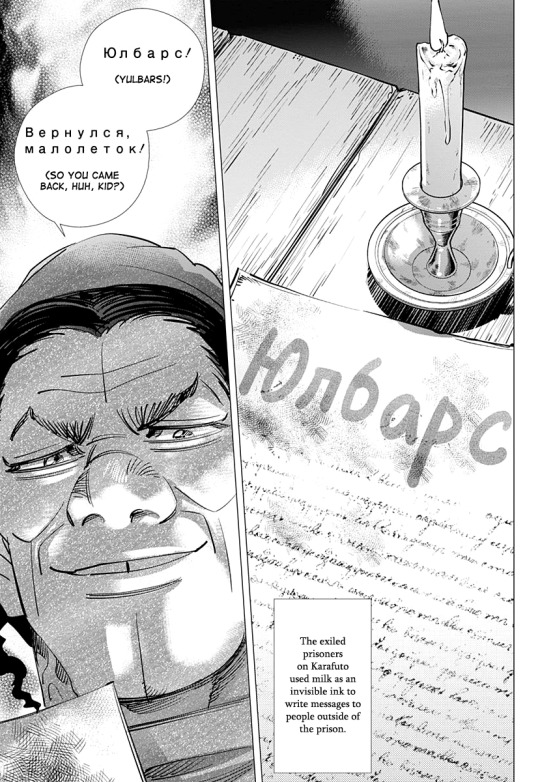
kiroranke speaks and is literate in russian, speaks japanese, ainu (both hokkaido and sakhalin dialects), uilta and nivkh languages, and most likely tatar too. he's so knowledgeable.
on a different note, sofia always refers to him as 坊や in japanese and малолетка in english, which means that she's a bit older than him. they knew each other since kiroranke was 15, and she was the mastermind behind the assassination of the emperor, so i'd guess that she was about 20. interestingly, i don't remember her referring to wilk in the same manner. kiroranke says that she knows about wilk even more than he does, so maybe they knew each other before they met him. i don't think sofia's and wilk's ages are ever brought up even in trivia materials. anyway it's either that wilk is closer to her in age than to kiroranke, or that she had too much respect for him to talk down to him. maybe it was inbetween and he was about 17-18? he did already sport that gross moustache after all
1 note
·
View note
Text

Women of The World:
Orok Woman, Russia,
by Olya Ivanova
Total population: 360 (est.)
The name Orok is believed to derive from the exonym Oro given by a Tungusic group meaning "a domestic reindeer". The Orok self-designation endonym is Ul'ta, probably from the root Ula (meaning "domestic reindeer" in Orok). Another self-designation is Nani.
Occasionally, the Oroks, as well as the Orochs and Udege, are erroneously called Orochons. The Uilta Association in Japan claims that the term Orok has a derogatory connotation.
Oroks (Ороки in Russian; self-designation: Ulta, Ulcha), sometimes called Uilta, are a people in the Sakhalin Oblast (mainly the eastern part of the island) in Russia. The Orok language belongs to the Southern group of the Tungusic language family. According to the 2002 Russian census, there were 346 Oroks living in Northern Sakhalin by the Okhotsk Sea and Southern Sakhalin in the district by the city of Poronaysk. According to the 2010 census there were 295 Oroks in Russia. via Wikipedia
Olya Ivanova, Born in 1981 in Moscow, Russia.
Received BA in literature, 2004
Graduated from Institute of Contemporary Art (Moscow), 2014
via Artist's website: www.olyaivanova.com
www.instagram.com/olbrevis
#OlyaIvanova #Ethnography #OrokPeople #PalianShow #womensart
3 notes
·
View notes